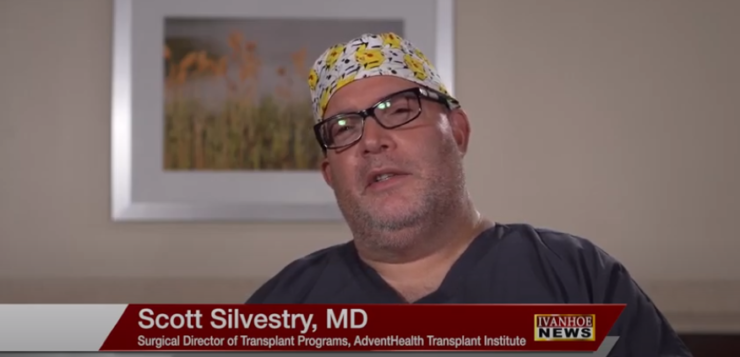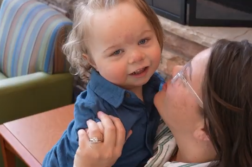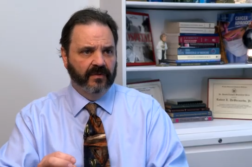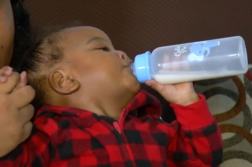Scott Silvestry, MD, Surgical Director, Thoracic Transplant Programs at Advent Health Transplant Institute talks about the groundbreaking technology of heart Donation after Circulatory Death.
Could you talk about donation after circulatory death?
Dr. Silvestry: The definition of death in the United States has been clearly defined by the loss of brain activity or brain death. Most transplants occur from donors who are brain dead and technically meet the definition of death. Donation after circulatory death is when someone has had a devastating illness or accident and valuable recovery is not possible, and their family stops care. They are terminating their care, or their families are limiting their care, so they die. In this pathway, patients who are suitable to donate organs after their death can become donors, and usually carers are withdrawn in a controlled setting. Sometimes they are on a breathing machine and when the breathing tube is taken out the heart naturally stops. Now, for other organs other than the heart like the liver, lungs, and kidneys, this period is important but not critical. For the heart, we are taking an organ that we believe still has life after it has already died, and what happens is the heart stops and the patient meets the definition of death. Then after a period of observation, the teams proceed with procuring the organs in an organized fashion.
How long is the organ viable for?
Dr. Silvestry: The organ is viable for a period depending on the age and medical conditions of the donor. Like the kidneys, pancreas, or liver there is a half-hour window when circulation stops, and preservative fluid is flushed to allow the organs to cool and be preserved for a transplant to occur. With the heart, it is a bit of a gamble. One of the reasons we had not previously used DCD hearts is the technology to resuscitate, assist, and then assess the heart really did not exist. That is where this current trial with TransMedics and other technologies such as Extracorporeal Membrane Oxygenation (ECMO) have been used. After a heart has stopped for a period, the question is, is it good enough? With these ways of reperfusion or reanimating the heart we can assess the heart. In the TransMedics trial, the heart is put on a big pump where it gets oxygenated blood, and we monitor the metabolism of the heart. When certain metabolic parameters are met, we know that the heart is good enough. So, we would not look at the heart and say this comes from a young person or an old person. We simply look at the metabolism of the heart after it is jumpstarted again and make decisions about whether it will be a suitable to go into someone and help them live the rest of their life normally.
From the study, have you found the average amount of time that it is viable for?
Dr. Silvestry: There are two times that are important. There is the time when the heart stops to when it is put onto a perfusion setup, and generally that is about half an hour. Once it is on and the heart is being perfused and getting blood supply again, the heart can go six to eight hours. They work in a much better way than hearts that have stopped and been put into a cooler for the same amount of time. We believe but have not yet proven that this type of technology will be key in extending the amount of time that hearts are donated in the standard way but will also allow us to take hearts from the DCD pathway and use them for even longer amounts of time.
That also increases the number of hearts you can use.
Dr. Silvestry: The best estimates suggest that if it were available in every transplant center, which it is currently not, if it were approved by the FDA, which it is currently not, and if it were done like in England or Australia that perhaps it could double all the available hearts in the United States for cardiac transplantation. Approximately 3,000 heart transplants are done in the United States and 99 percent of them have always been done by brain dead donation. Over time, if we could add 1,000, 2,000 and get to another 3,000 we would be doubling the number of patients we could help through this fantastic treatment.
How long has the clinical trial been going and how many patients have you performed this on?
Dr. Silvestry: The clinical trial is run by a company called TransMedics, which has the technology to profuse hearts. The first aspects of the clinical trial were simply in regular hearts and using them in the standard pathway compared to hearts that were in cold storage. With time, we have been able to extend from normal brain-dead donation to a deep deceased circuitry donation. That aspect of it has been going on for about a year and a half. In the trial itself, there has been about 40 hearts that have been utilized in our series. We have utilized two hearts out of that, and the initial results are very, very impressive, but of course we must wait for the study to end to look at all the patients and the results. Most importantly, if one enrolls in the trial while you are waiting for a heart transplant, some of the patients are limited to just the standard treatment. Those are the comparison group. The other group of patients are ones that can have either standard treatment if a heart becomes available or DCD hearts. If that option becomes available first and we generally tell our patients that the results are comparable in those two groups based on the best available information we have. But that is what we are trying to prove here in the United States.
Are there any particular people that this will be an ideal solution for? And are there some people that this would not be an option for?
Dr. Silvestry: Unfortunately, you must be limited to needing a heart only. Over the weekend we performed a heart and kidney transplant and heart and liver transplant. Both of those patients were not able to be in the trial because currently a second organ is an exclusion. If you fast forward when this is approved, any patient could utilize this pathway and would have the additional benefit of more potential donors. Right now, it is limited to single organ heart but in the future, we do not believe it will be limited to just that. There are some advantages to certain patients. Based on the current system of allocation, there are patients who have congenital abnormalities or there are patients with certain diseases. These patients do not get sick in the same ways, so their priority in the current allocation system for hearts is lesser. Some of these patients have a tremendous advantage because they can get organs through this pathway and they work particularly well in this population. So, there is a variety of different combinations that we think will help.
What implications do you believe this would have for transplant surgeries in general?
Dr. Silvestry: I think increasing the number of organs available would be a tremendous boon to patients in need. Every year patients die waiting for a heart transplant and allowing us to utilize the organs from patients that are already going to die, and are simply going to be buried, would be a tremendous addition. It has the potential to save three to four thousand additional patients a year and that is worth pursuing. We are grateful not only to the company, but to the patients who are participating in the trial so we can show that this therapy is safe and effective and allow it to be approved by the FDA so that ultimately any patient can have it.
Is the surgery itself or even the recovery any different than a regular heart transplant?
Dr. Silvestry: The recovery is virtually the same. The first two patients have done phenomenally well and went home in a short period of time. One of my colleagues and mentors who is at Duke University said that he did not think this was going to work at all. But he has become a true believer by seeing how well these patients have done and he is a strong proponent of this technology and method at the current time.
Regarding the two patients, how long ago were those done?
Dr. Silvestry: Those two patients were all done within the last 40 days.
What do you think this will mean for someone’s quality of life if they have been waiting for a heart transplant?
Dr. Silvestry: When you talk to that patient, he was on the wait list for years before he became close enough to have what we call dress rehearsals and then ultimately a beautiful heart for him and a beautiful result. You know, many of our patients tell us when they are on the waitlist that they are living life in limbo. Many of them will tell you they feel like they have one foot in the world of the living and one foot in the world of the dead because they do not know if they are going to survive to the next day or week. They do not know if a heart will come and save them before they become too sick for a transplant. So, they live in this very uncertain and weird place. By allowing patients access to these organs and by decreasing the wait times, we think we are going to have a tremendous impact not only in how long they live and how much quality of life they have, but also in less amount of time in limbo. I think that in of itself is valuable to alleviate.
What are the next steps with the clinical trial it?
Dr. Silvestry: It is extremely exciting because when the clinical trial gets filled, the follow up period is necessary. We love it when transplant patients survive seven days, 30 days and even six months. But we really want to see this equivalent in terms of year, and years. When the follow up period for all the patients who are enrolled is met, and that includes both the control group, the comparison group, and the patients who receive DCD hearts, they will take all the information, and analyze it. It will be presented to a scientific community as well as to the FDA and then a panel that the FDA brings in of doctors and surgeons like myself and my colleagues who will evaluate it. Those physicians will not have been involved in the trial and look at the data objectively and say this is something that should be approved, or this is something that we need to have more information about. Then once it is approved, the information is spread out and the technology becomes available to every transplant center and every patient and then it becomes a mature technology.
Anything that I did not ask you that you feel people should know?
Dr. Silvestry: Consider organ donation. We all go about living our lives and we are terribly busy, but not just in ourselves and our loved ones. No one ever really wants a tragedy where they lose a loved one, but the only silver lining in many of these cases is the ability to save seven- or eight-people’s lives and the impact that they have over time. Many times, the only solace in these tragedies is the fact that their loved ones went on to help people and that effect gets cascaded whether it is a teacher, policeman, husband, wife, son, or daughter. The impact of the patients who receive these organs is far reaching and touches all of us.
With the DCD heart, are there any potential issues that occur outside of a regular heart transplant?
Dr. Silvestry: It is a little bit uncomfortable at first because our usual conduct is when the team member goes to procure the organ, they look at it and they give you the thumbs up. Then our site starts working on the transplant and we prepare everything so when the heart is back, we can simply put it in. In this case, because we are assessing the heart metabolically, until the heart is back or awfully close by, we do not start an operation. Sometimes it leads to longer nights and days because the procuring team has been working from midnight to 6 a.m. to get to Orlando and make sure that the heart is good, and then the operating team starts at that moment while the heart is sitting there in a box pumping and it is a little disconcerting. It is kind of like your mother watching you do your homework. You know you must do it faster; you know you must do it better, but it is a clear and persistent reminder that we must be efficient and move forward. But once you get used to that different order of circumstances, it is very relaxing, and it is an exceptionally good operation.
Interview conducted by Ivanhoe Broadcast News.
END OF INTERVIEW
This information is intended for additional research purposes only. It is not to be used as a prescription or advice from Ivanhoe Broadcast News, Inc. or any medical professional interviewed. Ivanhoe Broadcast News, Inc. assumes no responsibility for the depth or accuracy of physician statements. Procedures or medicines apply to different people and medical factors; always consult your physician on medical matters.
If you would like more information, please contact:
JEFF GRAINGER
JEFF.GRAINGER@ADVENTHEALTH.COM
Sign up for a free weekly e-mail on Medical Breakthroughs called First to Know by clicking here





